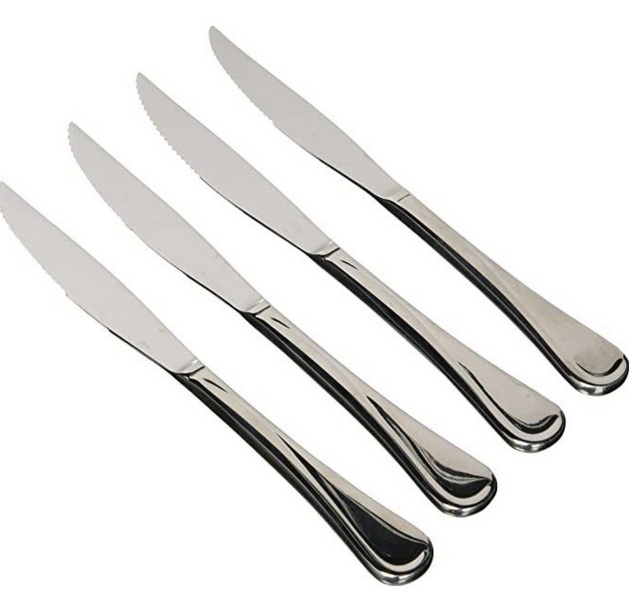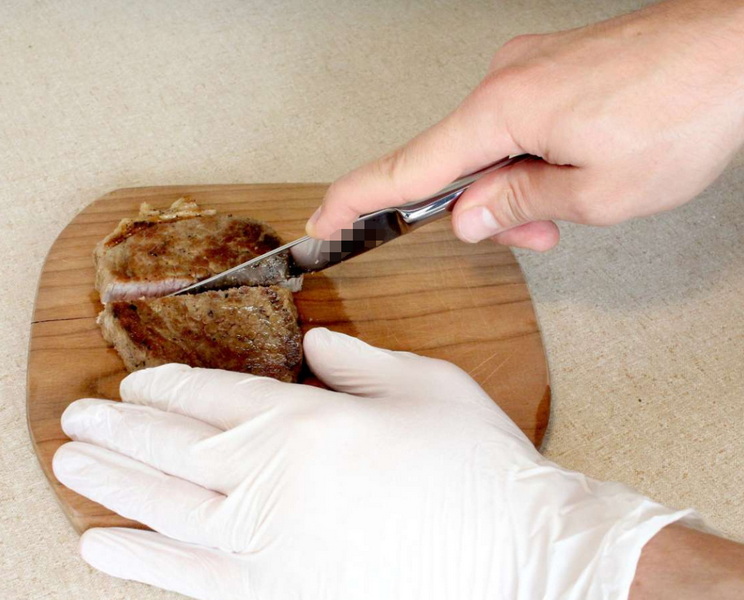- All
- Product Name
- Product Keyword
- Product Model
- Product Summary
- Product Description
- Multi Field Search
Views: 222 Author: Ann Publish Time: 2025-11-03 Origin: Site











Content Menu
● Why this topic matters for OEM partners
● 1: Core attributes of a high-value steak knife
>> Market readiness and compliance
● 2: Market-ready categories and value ranges
>> Serrated vs straight-edged steak knives
>> Budget steels and construction approaches
>> Price positioning and value storytelling
● 3: Quality signals in a budget-friendly package
>> Maintenance and care guidance
>> Brand and marketing alignment
● 4: Design and production choices for OEM collaborations
>> Blade materials and heat treatment
>> Edge options and performance targets
>> Handle materials and branding
● 5: Case examples and decision frameworks
● FAQ
>> 1) What defines an affordable Steak Knife that still delivers quality?
>> 2) Should OEM buyers prefer serrated or straight-edged models in budget lines?
>> 3) Which steels are most cost-effective for reliable performance?
>> 4) What is the impact of forging versus stamping in budget ranges?
>> 5) How can OEMs tailor a steak knife for global markets?
In the modern kitchen, a dependable steak knife is more than a tool—it is a bridge between craft and cuisine. For brands, wholesalers, and manufacturers operating in global OEM spaces, delivering a line of steak knives that balances affordability with uncompromising quality is essential. This guide delves into the key factors that define value in a steak knife, including blade geometry, steel selection, handle ergonomics, edge retention, and overall durability. It also provides practical guidance for selecting, designing, and marketing an affordable yet high-performing steak knife lineup suitable for diverse international markets. Throughout, the emphasis remains on the performance and value of the Steak Knife, highlighting what to look for in cost-conscious solutions without sacrificing cutting precision, safety, or aesthetics. This article targets manufacturers and brand partners seeking scalable, budget-friendly options that meet global standards and consumer expectations.

- OEM buyers must balance price with quality to satisfy international distributors and end consumers.
- Transparent design choices—blade steel, grind, heat treatment, and handle materials—drive reliability and market acceptance.
- Strong media assets (photos and videos) accelerate go-to-market timelines and reduce post-sale support needs.
- The blade's shape determines how cleanly meat sections separate and how easily fat or sinew is managed. A well-designed geometry reduces tearing and minimizes fatigue during long service.
- Edge profile, whether straight or serrated, affects cutting performance on different meats. Serrations excel for flexible maintenance in busy environments; straight edges offer precision for premium cuts and fine carving. End users, distributors, and OEMs should align geometry with target cuisines and service settings.
- Steel selection governs hardness, corrosion resistance, and edge retention. Common budget-friendly options include stainless alloys with balanced toughness and wear resistance; some OEM programs leverage carbon-stainless hybrids to maximize performance-to-cost.
- Finishing steps—grinding, heat treatment, and surface polishing—determine notch sensitivity, resilience to corrosion, and overall feel in hand. Proper tempering ensures a steel that remains sharp under routine kitchen tasks while resisting staining.
- Ergonomics influence fatigue reduction during extended slicing sessions. A well-balanced Steak Knife feels comfortable in the grip, with a handle that avoids hotspots and provides secure purchase even with wet hands.
- Materials range from durable polymer composites to natural woods or layered laminates. For OEM projects, choose handles that withstand dishwasher cycles, resist staining, and present visually compatible aesthetics with partner brands.
- A high-performing budget Steak Knife should tolerate routine cleaning, occasional sharpening, and daily kitchen wear. Resistance to corrosion, micro-scratches, and microscopic pitting are key indicators of long-term value.
- Maintenance guidance—proper washing, drying, and sharpening routines—extends blade life and keeps edge quality consistent across a product line.
- Adherence to international safety and labeling standards, packaging regulations, and warranty expectations is essential for OEM success in multiple regions.
- Providing clear media assets and technical data sheets accelerates product onboarding with distributors and retailers.
- Serrated steak knives are often favored in high-volume settings due to lower sharpening needs and dependable performance on tougher cuts.
- Straight-edged steak knives deliver superior precision on tender meats and fine slices, appealing to upper-midmarket and premium segments.
- For OEM programs, a blended lineup often works best: a serrated core model for value-focused markets and straight-edged variants for specialty channels.
- Stainless steels with balanced hardness offer corrosion resistance and ease of maintenance at lower cost.
- Forged blades generally provide better rigidity and edge stability, while stamped blades can reduce cost and weight; heat treatment and grinding quality can compensate for other cost differences.
- Bolsters and full tang constructions contribute to perceived durability and balance, which matters in consumer-perceived value and brand perception.
- Price bands commonly range from entry-level to mid-range, with tangible differentiators in edge retention, comfort, and presentation.
- Value storytelling should emphasize tangible benefits: longer-lasting sharpness, easier maintenance, fatigue-free handling, and reliable performance in varied culinary contexts.

- Consistent blade grind lines, well-aligned tips, and solid bolster transitions signal attention to manufacture quality.
- Seamless handle-to-blade junctions reduce stress concentrations and improve washability.
- Packaging that protects during transport and clearly communicates the Knife's value proposition helps convert buyers.
- Clear instructions for hand-washing versus dishwasher compatibility, drying regimes, and routine honing help customers maximize life and maintain performance.
- Media assets should illustrate care steps to reduce misuse and returns, improving customer satisfaction.
- Consistent imagery and messaging across regions reinforce the value story. For OEMs, providing ready-to-use media kits with product photos, lifestyle shots, and video demonstrations reduces time-to-market and supports uniform brand presentation.
- Selecting appropriate steel chemistries and heat-treatment profiles is central to delivering a dependable balance of hardness, toughness, and corrosion resistance at scale.
- Consistency across batches is critical for OEM partners, ensuring that every production lot meets defined tolerances and customer expectations.
- Decision points include serrated vs straight-edge, and whether to offer partial serration or full serration on specific models.
- For mass-market lines, a well-tuned serrated version can outperform budget straight-edge knives in tougher tasks, while straight edges can command premium segments.
- Handle material choices influence grip feel, maintenance needs, and visual appeal. For OEMs, compatibility with branding colors, logos, and packaging graphics is essential.
- Consider water and chemical resistance, washability, and lifecycle cost when selecting handle materials for multi-region distribution.
- Forged blades tend to offer superior rigidity and edge stability, but require more investment; stamped blades reduce cost but must be engineered to retain form under use.
- The choice between full tang versus partial tang, bolster style, and rivet patterns impacts aesthetics, balance, and production efficiency.
- Quality-control checkpoints should be embedded at each stage—from blank formation to final finishing—to ensure uniform performance across the entire OEM program.
- Scenario A: An OEM partner seeks a mass-market Steak Knife lineup for multiple regions with a focus on durability and easy maintenance. Recommendation: a serrated-edged, stamped blade with a robust polymer handle, balanced for all-day kitchen use, paired with a media kit that highlights toughness and dishwasher-friendly care.
- Scenario B: A premium channel partner requests a straight-edged Steak Knife with excellent edge retention and a refined handle aesthetic. Recommendation: a forged blade with a corrosion-resistant finish, a attractive appearance handle material that aligns with branding, and a media plan emphasizing craftsmanship and long-term performance.
- Scenario C: A distributor prioritizes packaging and shelf presence. Recommendation: strong packaging design and high-contrast product imagery, plus a video demonstration of precise carving on premium cuts.
A well-designed, affordable Steak Knife program can deliver strong performance across diverse global markets without sacrificing quality or brand integrity. By prioritizing blade geometry, steel selection, ergonomic handles, durability, and consistent finishing, OEM partners can offer a compelling value proposition that meets real culinary needs and stands up to daily use. The implementation of a robust media strategy—photos, videos, and clear product storytelling—further strengthens market adoption and supports distributor confidence. For foreign-brand partners, a thoughtfully engineered Steak Knife lineup becomes a scalable driver of growth, enabling faster time-to-market and clearer differentiation in competitive global markets.

- A thoughtful combination of blade geometry, appropriate steel selection, reliable edge retention, ergonomic handle design, and durable finishing—delivered through efficient manufacturing and strong QA—creates true value in an affordable Steak Knife.
- Serrated edges reduce sharpness maintenance and perform well on tougher cuts, while straight-edged blades offer cleaner slices and easier sharpening for certain cuisines; offering both in a coordinated OEM lineup provides flexibility across markets.
- Common choice families include stainless steels with balanced wear resistance and corrosion protection, supplemented by proper heat treatment to maximize hardness and durability within budget.
- Forged blades typically provide better rigidity and fatigue resistance, while stamped blades lower cost and weight; with optimized heat treatment and grind, stamped blades can still meet robust performance targets for cost-conscious markets.
- Align blade edge, steel choice, handle material, and finish with regional dining practices, maintenance habits, and dishwasher norms; pair with scalable manufacturing and a media kit designed for local channels.
The Ultimate Professional Knives for Halal Butchery in Middle Eastern Kitchens
Chef Knife Size Guide: Choosing Between 6″, 8″, 10″, And 12″
Custom Knife Handles: How To Design A Chef Knife That Fits Your Hand Perfectly
Chef Knife Surface Treatments Guide: From Polished Migaki To Damascus Patterns
Inside Our Professional Knife Sample Room: Quality You Can See
Universal Knife Block Buying Guide: Modern Acrylic & ABS Knife Holders for Professional Kitchens
Universal Knife Block: The Complete Guide To Modern, Hygienic Knife Storage
The Complete Guide To Red Handle Knife Sets: Style Meets Functionality in The Kitchen
Professional Knives for Halal Butchery And Middle Eastern Cuisine